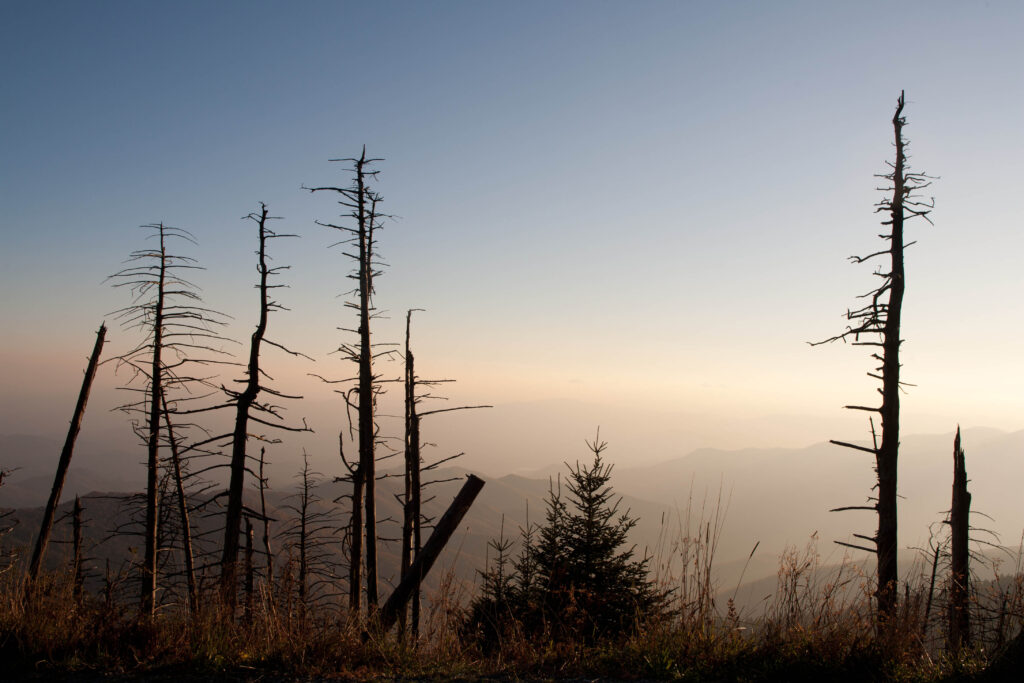Climate Change and Trees, Pt. 2
Climate Change and Trees, Pt. 2
Effects of Climate Change on Trees
by Erin Trombley
Climate change presents a number of challenges for our trees. For fall foliage, for example, warmer springs, summers, and falls have an effect on fall color display. In an article published by Washington University in St. Louis, Susanne S. Renner, honorary professor of biology in Arts & Sciences, explained that warm springs make for earlier foliage color change, contrary to the notion that warming is delaying the onset of fall color. Imagine your fall foliage trip not so much during sweater weather, but rather in shorts. When the summer is dry and/or if late September and early October nights lack frost, the leaves will be more brown and muted. Worse yet, different types of trees are impacted differently by the variables in the weather and so a more dispersed display may result. If a reliable timeframe and brightly-colored leaves are less common, this could impact the fall tourism industry and local economies that rely on those dollars.
According to ISO Certified Arborist Paul Hetzler, 90% of tree roots are no more than 10” deep. 98% are 18” deep or less. That means trees are very susceptible to changes in weather and temperature. Both drought and flooding can cause roots to die back, which can take years for trees to fully recover from. Lacking a thick blanket of insulating snow in the winter, tree roots are more likely to sustain damage from Adirondack cold temperatures. Starches stored in roots that die back are lost to the tree. To grow new roots, a tree needs extra nutrients and water, resources it is less able to access due to compromised roots.

While compromised, trees are more prone to root and wood rot, deadly cankers like Chaga, and are more sensitive to chemicals, such as pollution and acidification. Weakened trees are also more prone to suffer from diseases like beech bark disease (BBD), and invasive species such as emerald ash borer (EAB), Asian long-horned beetles (ALB), spongy moth, and hemlock woolly adelgid (HWA). In the case of the latter, we know it’s possible for infestation from a single invasive species to devastate a population of trees. HWA has already wiped out large stands of hemlocks in the Smoky Mountains and was first detected in the Adirondacks in 2017. Global warming makes new places suitable for many invasive species, encouraging them to spread.

After an international study of 200,000 samples of 82 tree species, a 2020 report by Consejo Nacional de Investigaciones Científicas y Técnicas (CONICET) concluded that elevated CO2 emissions cause trees to grow faster and die earlier than they would normally. That means carbon stored in forests would be reintroduced into the atmosphere sooner than anticipated. Another study by Hans Pretzsch, Peter Biber, Enno Uhl, and Thomas Rötzer, scientists at the Technical University of Munich in Germany, found the rate of spruce and beech growth in Maryland, Central Europe, and Finland since 1870 accelerated almost 77%!
Further, Pretzsch et al looked into the effects of elevated CO2 on the quality of the wood. They sampled sessile oak, European beech, Norway spruce, and Scotch pine in plots that have been monitored since 1870. They found an 8-12% reduction in wood density, meaning the wood is softer. Softer wood makes trees more likely to sustain damage in extreme weather events and high winds, impacting local infrastructure, homes, buildings, and other trees. The study also found that the lower the density of the wood, the less carbon content. Carbon content was reduced by as much as 50% in the less dense wood. Considering the global importance of tree carbon sequestration in holding back the tide of global warming, this does not bode well.
With climate change comes erratic weather patterns. Beneath the variables of El Niño and La Niña weather patterns, global warming is causing sustained droughts and record-breaking heat waves, floods, blizzards, and unusual deep freezes by weakening the jet stream. Once again wildfires are a major concern for our beloved Adirondack trees, as demonstrated by our neighbors in Quebec, fighting over 100 fires in June of this year. The cloud of smoke from those fires covered numerous states and made the air dangerous to breathe in some places.
With increasing frequency, we have seen the severity of damage wildfires cause out west. According to Congressional Research Service in June of this year, over 7 million acres burn in US wildfires each year. Thousands burn in New York annually. As I write this, even after several days of rain, drought.gov is reporting that 75% of the state of New York is abnormally dry, and an additional 12.9% is experiencing moderate drought, with 1.5 million NY residents experiencing drought. That creates a lot of potential for fire.
All of these climate change-related challenges impact trees around the world, and therefore also our North Country trees and the industries that rely on them. Tree loss here and around the globe poses a threat to not just timber and tourism, but to homeowners, communities, public infrastructure, wildlife, ecosystems, and to the larger picture of the health of our state, the nation, and our global community.
Room for Hope
These issues are not sneaking up on us. In the case of wildfire, the New York State Department of Environmental Conservation (NYSDEC) has a plan. Prescribed fires are used as a fire prevention tool and mutual aid agreements have been made with other state agencies, the National Guard, National Park Service, US Fish and Wildlife Service, and the provinces of Quebec, Newfoundland Labrador, and New Brunswick to ensure we have coverage to get any wildfires that do flare up under control.
The NYSDEC Division of Lands and Forests manages almost 5,000,000 acres across the state, most of which offer recreation opportunities to the public. They also run the Colonel William F. Fox Memorial Saratoga Tree Nursery, where over 1.5 million seedlings are grown and where the public can get plants and trees for their properties each spring. Since 74% of NY Forests are privately owned, the state also offers the EQIP Forestry Initiative, which provides technical and financial assistance to help private forestland owners to manage their land for the health of their trees and wildlife.

Further, any number of private organizations and individuals are advocating for and assisting with land management for the overall health of our trees and public lands. ADK is proud to be among those. On a broader scale, slowing the advance of global warming is on everyone’s mind. From the individual homeowner to worldwide governments, scientific communities, and organizations around the globe, virtually everyone understands the critical nature of slowing, stopping, and we dare hope to reverse the warming trend, for the sake of life on earth as we know it. As it happens, trees are some of the best weapons to fight global warming. SUNY ESF’s professor of forest and natural resources management, Colin Beier, stated in a 2019 Adirondack Explorer article: “Natural carbon sinks are natural climate solutions. Forests are among our most efficient and cost-effective means of reducing greenhouse gas emissions and stabilizing atmospheric carbon dioxide levels.” If we take care of trees, trees will help take care of us.
Click here to read part 1, “The Tree-conomy,” about how trees have supported our economy for centuries.
Related
ADK Applauds Updates to Adirondack Park State Land Master Plan
ADK appreciates the Adirondack Park Agency’s (APA) recent updates to the proposed final amendments to […]
Forest Preserve Advocates Applaud Final 2025–26 Budget
May 13, 2025–Albany, NY: Over forty organizations and municipalities advocating for New York’s Forest Preserves […]
Adirondack Conservation Organizations Urge Park Agency to Drop Controversial Motor-Vehicle Plan
February 17, 2025 — Ray Brook, NY — Adirondack conservation organizations today said they were […]
ADK Advocates for the EPF
February 10, 2025—Adirondack Mountain Club (ADK) staff spent the day at the Albany Capitol during […]

